Clustering case
Contents
Clustering case¶
%matplotlib inline
import pandas as pd
import matplotlib.pyplot as plt
import seaborn as sns
from sklearn.preprocessing import StandardScaler
from sklearn.cluster import KMeans
from sklearn.cluster import AgglomerativeClustering
Case description¶
Suppose a financial technology (fintech) startup conducted an online survey and obtained data from 1010 individuals. All respondents agreed to receive marketing material from the company.
The data file responses.csv contains the data from the questionnaire and consists of 1010 rows (people) and 150 columns (139 integer and 11 categorical). See the data description PDF for a detailed overview of the data.
Let’s imagine that after the fintech startup collected the data, they realized that they forgot to include a question regarding wether the respondent is male or female. Since this information is vital to an upcoming marketing campaign which is targeted specifially at women, they decide to use two different clustering methods to figure out wether an individual is male or female based on their reported height and weight.
A) Data preparation
Import the data (responses.csv), call the DataFrame
dfand delete all observations with missing infomation (”df.dropna(inplace=True)”). - Next, create a new DataFrame calleddf_1where you only select the variablesHeight,Weightand alsoGender.Visualize the variables
HeightandWeightin a scatterplot.
Note that we pretend the variable Gender is missing but select it anyway in order to compare the results from the clustering methods with the real gender our observations. However, it is important to note that in real use cases, the cluster analysis is performed if there are no Y-labels (like Gender) available.
B) Standardization
Create a new DataFrame (call it
X) with onlyHeightandWeightStandardize the variables (with
StandardScaler), store them in a new DataFrame (calledX_std)Visualize the result in a scatterplot.
C) k-Means
Use k-Means to determine the two clusters in the dataset
X_stdand visualize the result (label the two clusters as points with different colors and display the cluster centers).Furthermore, save the result as a new variable (
gender_kmeans) in the original DataFramedf.
D) Hierarchical Clustering (Ward)
Apply hierarchical clustering with Ward’s method to the data (
X_std)Visualize the result (label the two clusters as points with different colors).
Furthermore, save the result as a new variable (
gender_ward) in the original DataFramedf.
E) Scatterplots
Next, we use Seaborn to create three different separate scatterplots in which we visualize the variables Height and Weight together with
(1) the variable
Gender(as points with different colors) from the DataFramedf,(2) the variable
gender_kmeans(as points with different colors) from the DataFramedf,(3) the variable
gender_ward(as points with different colors) from the DataFramedf.
See Seaborn’s documention to understand the syntax.
F) Comparision
a) What differences do you observe in the results? How do the clustering-results differ?
Now compare the result with the actual gender variable to the clusters of k-Means and hierarchical cluster analysis (note that this is not possible in real world cases since we usually don’t have true labels). Answer the following questions:
Which cluster method performed better if the company has the following goal:
b) address as many women as possible.
G) Data finalization
Assume the company decides to use the k-means clustering results. Hence, we create a new DataFrame called df_3 where we only keep observations which are labeled as female in the gender_kmeans result.
Solution¶
A) Data preparation¶
df = pd.read_csv("https://raw.githubusercontent.com/kirenz/datasets/master/responses.csv")
df.dropna(inplace=True)
df_1 = df[['Weight','Height','Gender']]
df_1.info()
<class 'pandas.core.frame.DataFrame'>
Int64Index: 674 entries, 0 to 1009
Data columns (total 3 columns):
# Column Non-Null Count Dtype
--- ------ -------------- -----
0 Weight 674 non-null float64
1 Height 674 non-null float64
2 Gender 674 non-null object
dtypes: float64(2), object(1)
memory usage: 21.1+ KB
sns.scatterplot(x='Weight', y='Height', data=df_1);

B) Standardization¶
# Standardization of features
X = df[['Weight','Height']]
scaler = StandardScaler()
X_std = scaler.fit_transform(X)
plt.scatter(X_std[:, 0], X_std[:, 1], s=40);
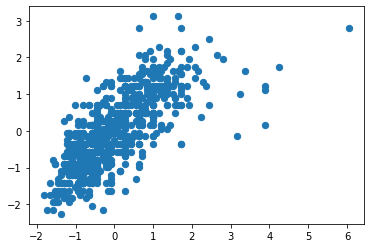
C) k-Means¶
kmeans = KMeans(n_clusters=2)
kmeans.fit(X_std)
KMeans(n_clusters=2)
y_kmeans = kmeans.predict(X_std)
plt.scatter(X_std[:, 0], X_std[:, 1], c=y_kmeans, s=50, cmap='viridis')
centers = kmeans.cluster_centers_
plt.scatter(centers[:, 0], centers[:, 1], c='black', s=200, alpha=0.5);
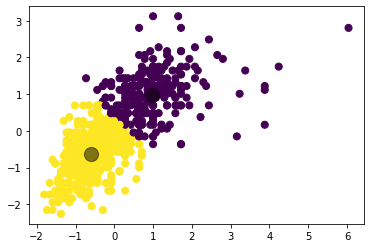
df['gender_kmeans'] = y_kmeans
D) Hierarchical Clustering (Ward)¶
ward = AgglomerativeClustering(linkage='ward', affinity='euclidean', n_clusters=2)
ward.fit(X_std)
AgglomerativeClustering()
plt.scatter(X_std[:, 0], X_std[:, 1], c=ward.labels_, s=50, cmap='viridis');
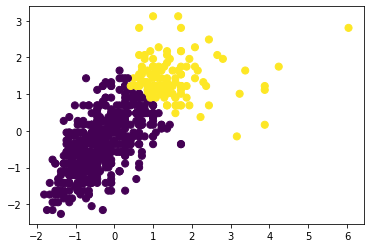
gender_ward = ward.fit_predict(X_std)
df['gender_ward'] = gender_ward
E), F) Compare results¶
sns.scatterplot(x='Weight', y='Height', hue='Gender', data=df);
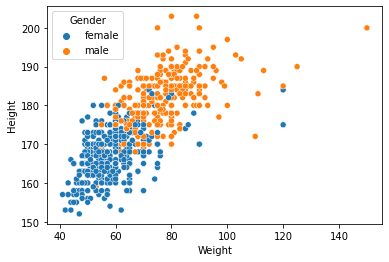
df['Gender'].value_counts()
female 402
male 272
Name: Gender, dtype: int64
# K means
sns.scatterplot(x='Weight', y='Height', hue='gender_kmeans', data=df);
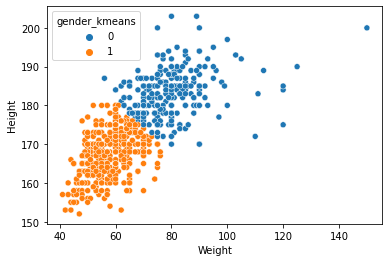
df['gender_kmeans'].value_counts()
1 413
0 261
Name: gender_kmeans, dtype: int64
#Ward
sns.scatterplot(x='Weight', y='Height', hue='gender_ward', data=df);
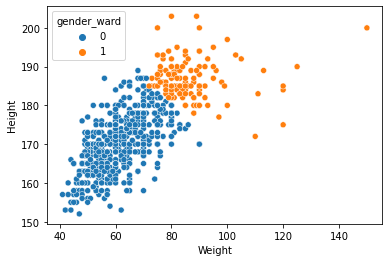
df['gender_ward'].value_counts()
0 548
1 126
Name: gender_ward, dtype: int64
G) Finalize data¶
df_3 = df[df.gender_kmeans == 1]
df_3.head()
| Music | Slow songs or fast songs | Dance | Folk | Country | Classical music | Musical | Pop | Rock | Metal or Hardrock | ... | Weight | Number of siblings | Gender | Left - right handed | Education | Only child | Village - town | House - block of flats | gender_kmeans | gender_ward | |
|---|---|---|---|---|---|---|---|---|---|---|---|---|---|---|---|---|---|---|---|---|---|
| 0 | 5.0 | 3.0 | 2.0 | 1.0 | 2.0 | 2.0 | 1.0 | 5.0 | 5.0 | 1.0 | ... | 48.0 | 1.0 | female | right handed | college/bachelor degree | no | village | block of flats | 1 | 0 |
| 1 | 4.0 | 4.0 | 2.0 | 1.0 | 1.0 | 1.0 | 2.0 | 3.0 | 5.0 | 4.0 | ... | 58.0 | 2.0 | female | right handed | college/bachelor degree | no | city | block of flats | 1 | 0 |
| 2 | 5.0 | 5.0 | 2.0 | 2.0 | 3.0 | 4.0 | 5.0 | 3.0 | 5.0 | 3.0 | ... | 67.0 | 2.0 | female | right handed | secondary school | no | city | block of flats | 1 | 0 |
| 4 | 5.0 | 3.0 | 4.0 | 3.0 | 2.0 | 4.0 | 3.0 | 5.0 | 3.0 | 1.0 | ... | 59.0 | 1.0 | female | right handed | secondary school | no | village | house/bungalow | 1 | 0 |
| 6 | 5.0 | 5.0 | 5.0 | 3.0 | 1.0 | 2.0 | 2.0 | 5.0 | 3.0 | 1.0 | ... | 50.0 | 1.0 | female | right handed | secondary school | no | village | house/bungalow | 1 | 0 |
5 rows × 152 columns

 Run in Google Colab
Run in Google Colab